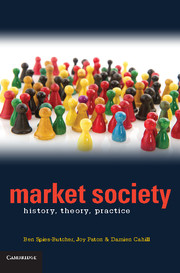Book contents
2 - Production, value and commodification
from Part 1 - Constituting market society
Published online by Cambridge University Press: 05 June 2012
Summary
IN THE INTRODUCTORY chapter we discussed how the rise of markets was associated with significant social transformations affecting the way people lived and worked. Workers increasingly left the fields and subsistence production to enter into cities where production was organised in factories and wage labour provided a different form of livelihood. This was a gradual but monumental shift creating the conditions for some to acquire immense material wealth. Subsistence production, in which items were generally produced by households for their own use, was transformed into a system of commodity production.
Commodity production is distinct from subsistence production in feudal economies because items are produced for the specific purpose of selling them for profit. Goods or services produced for sale are commodities. In this chapter we explore the concept of the commodity and its implications for how we understand market society. We introduce key ideas addressed in economic theory including economic value, consumer sovereignty and the price mechanism. We also consider how some commodities are created beyond production through the process of commodification.
- Type
- Chapter
- Information
- Market SocietyHistory, Theory, Practice, pp. 19 - 42Publisher: Cambridge University PressPrint publication year: 2012



